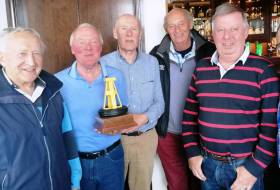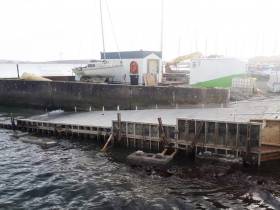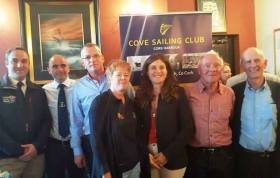Displaying items by tag: Monkstown Bay
Blustery Laser Racing for Monkstown Bay Sailors in Cork Harbour
Local Laser sailor Chris Bateman emerged as the winner of today's three races of the Monkstown Bay Sailing Club's Yard of Ale Trophy in Cork Harbour.
The 14-boat fleet braved strong gales for today's series, the first dinghy racing of the new year.
Second overall was Ronan Kenneally with third place going to Sunday's Well Sailing Club's Paul O'Sullivan.
 Monkstown Bay Sailing Frostbites Results 2022
Monkstown Bay Sailing Frostbites Results 2022
At Monkstown Bay Sailing Club in Cork Harbour, Ronan Kenneally leads the July dinghy league in his Laser on 2 points, with John Moynihan 2nd in another Laser on 5 and Michael and Sandy O'Brien sailing a 505 in third place on 7.
As regular Afloat readers will know, Cork Harbour is the venue for next year's 505 World Championships where MBSC members will compete on home waters in August 2022.
'Goldie' Goes to Monkstown Bay Class Captain
Monkstown Bay Sailing Club Cruiser Class in Cork Harbour honoured their Class Captain Henry Jefferies, awarding him the ‘Goldie Cronin’ Trophy for dedicated service to the Class.
The trophy race is in honour of the late ‘Goldie’ Cronin who was Race Officer for the Cruiser Class for many years. Before that she had served as OOD – Officer of the Day – for the Vagabond dinghy class which was once the biggest class of boats raced at Monkstown. Many of its members graduated, on age grounds as they became more mature (!) into the formation of the club’s Cruiser Class and ‘Goldie’ moved with them. She was a “commanding and resolute figure” on the Sand Quay as she ran races, members of the Class recalled.
In presenting the trophy to Henry Jefferies, the Class paid tribute to him for his years of dedicated service. “It is a testament to his commitment and dedication and to how he has kept the Class alive over the past two years with his tireless efforts both within MBSC and the combined Cork Harbour clubs,” the Cruiser Class tribute said.
The unique trophy recalls the former ‘Alta’ race mark at Monkstown, around which ’Goldie’ insisted that boats should finish at the Sand Quay club line, to demonstrate their sailing abilities!
Monkstown Bay Race Concludes Cork Harbour Cruisers League
The combined clubs Cork Harbour league concluded on Saturday, run by Monkstown Bay Sailing Club’s Cruiser Class and with nine yachts racing writes Tom MacSweeney
The race started at No.9 buoy with a beat to No.5, then swinging on a starboard turn to the Cage, where the wind turned bit fickle as the nine boats were faced with a beat out to No.3. Having rounded there to starboard, the tide favoured them back to No.6, across the harbour to No.8, then crossing the harbour again to No.7, from there to No.9, No.13 and a very tricky last leg to finish at 18. That saw the fleet encounter particularly challenging wind patterns in a light breeze, before they got across the finishing line.
The IRC handicap Ward and Burke Trophy was won by Dave Doyle’s Musketeer from Great Island Sailing Club. Second was Esme, John and Fiona Murphy from the RCYC at Crosshaven and third Ria Lyden’s Ellida also from the RCYC.
In ECHO handicap Ellida was the overall winner of the Ward/Burke Trophy, with Sean Hanley’s Luas second and third was Esme.
Photos below by Bob Bateman
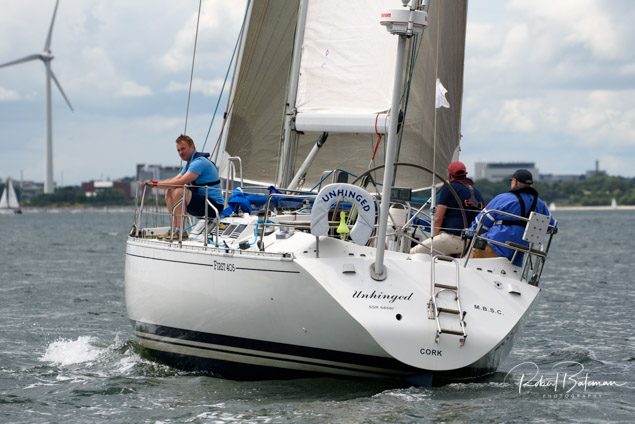 Chris Granby Jr’s Unhinged
Chris Granby Jr’s Unhinged
The top Monkstown boat in the series was Chris Granby Jr’s Unhinged, which won the Charlie Hennessy Trophy, awarded in memory of one of MBSC’s legendary sailors. Second in the home club’s internal league, based on the overall results, was Sean McCarthy’s Sally. The June MBSC League prize was also presented after racing on Saturday and the winner was again Chris Granby.
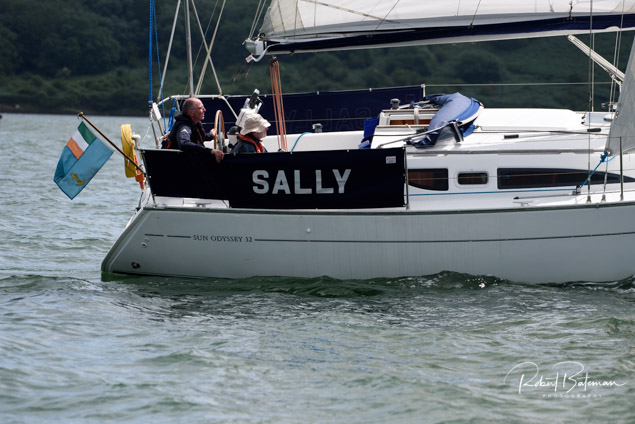 (Above and below) Sean McCarthy’s Sally
(Above and below) Sean McCarthy’s Sally
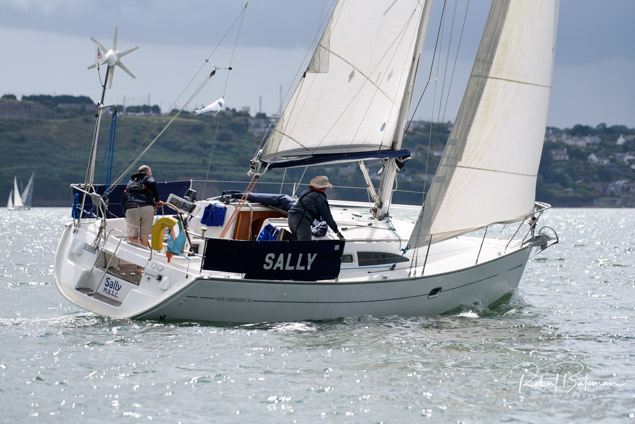
MBSC Class Captain Henry Jefferies said the league had been a successful involvement between the three harbour clubs, with MBSC providing the race officer teams and RCYC compiling the results. The June League was run by Great Island Sailing Club and in September RCYC will organise the racing.
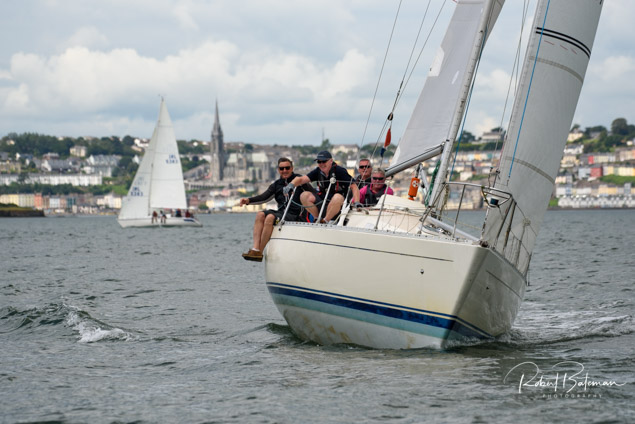 The IRC handicap Ward and Burke Trophy was won by Dave Doyle’s Musketeer from Great Island Sailing Club
The IRC handicap Ward and Burke Trophy was won by Dave Doyle’s Musketeer from Great Island Sailing Club

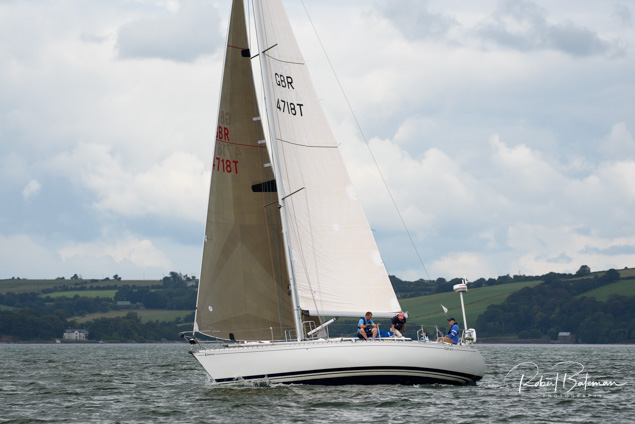

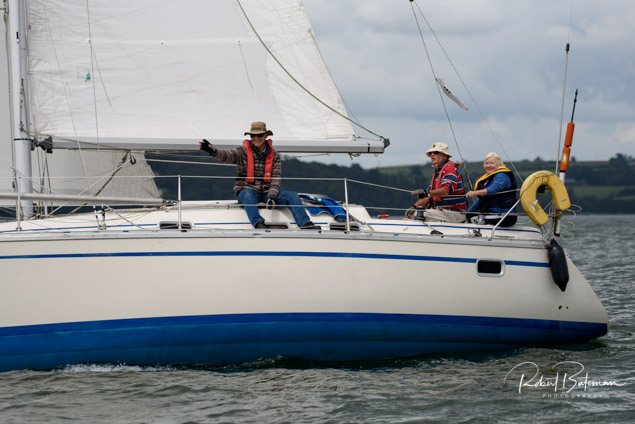
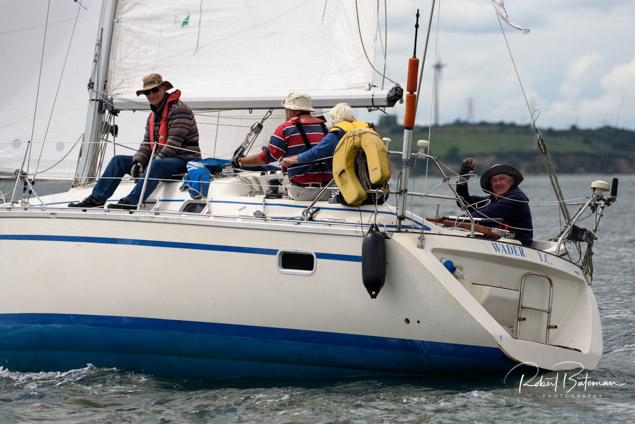
Cork Harbour Slipway Extension at Monkstown Bay
Monkstown Bay in Cork Harbour is getting a slipway extension which will improve boat launching and recovery. The previously narrower slipway is being renewed and widened.
The slipway is at the upriver side of the Sand Quay which is primarily used by Monkstown Bay Sailing Club for launching dinghies, but it is a public slipway, also generally available.
MSBC has a club hut for race operations on the Quay. Its clubhouse is a short distance away at De Vesci Place in the village.
Cove Sailing Club Announces Link-up With Monkstown Bay to Boost Cruiser Racing in Cork Harbour
Cove Sailing Club launched its programme for the season with confirmation of joint cruiser racing to be sailed with neighbouring Monkstown Bay SC in an attempt by both clubs to boost cruiser participation in Cork Harbour writes Tom MacSweeney.
Cove SC Commodore Joanna Radley and Monkstown Bay’s Cruiser Class Captain Henry Jefferies said that the development had been discussed for some time and that both clubs would continue to have their own dedicated events, while also combining racing which would be held alternately at Cobh and Monkstown. Both clubs had experienced declining fleet numbers over recent seasons and this was a determined attempt to reverse the trend.
Royal Cork Yacht Club’s Rear Admiral for Keelboats, Kieran O’Connell, who was present welcomed the development and said that the RCYC would look forward to the possibility of joining in next season when all three clubs could strengthen cruiser racing.
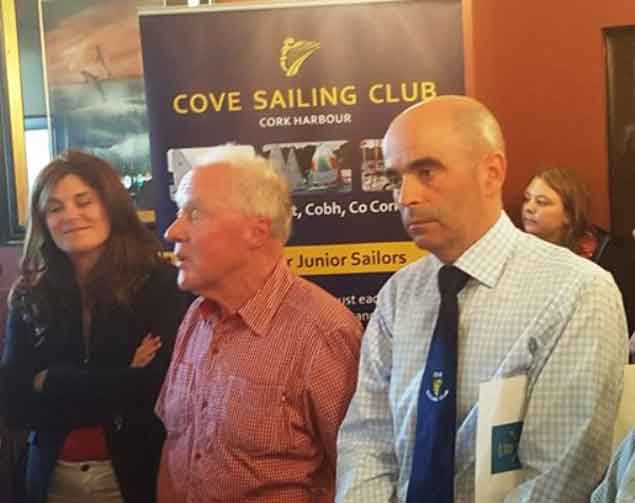 Cove Sailing Club Commodore Joanna Radley, Monkstown Bay Cruiser Class Capt Henry Jefferies and Cove Sailing Secretary Pat Coakley at the Announcement of the Joint Racing programme
Cove Sailing Club Commodore Joanna Radley, Monkstown Bay Cruiser Class Capt Henry Jefferies and Cove Sailing Secretary Pat Coakley at the Announcement of the Joint Racing programme
“This is a wonderful harbour, with great opportunities for sailing, of which every opportunity should be taken,” is the approach being taken by the clubs. The joint Cove/MBSC events will concentrate on whitesail, which is the focus of Monkstown Bay SC cruisers. Cove includes spinnakers in its racing events.
The agreed approach, as previously reported by Afloat.ie will start with both clubs joining forces for the first time on Sunday May 21, starting together on the Cove SC line and again the following Saturday, May 27 On Saturday, June 3, the June Bank Holiday Weekend both clubs will race in Monkstown. The clubs will gather together again in Cobh on four Fridays in June – 9, 16, 23 and 30. A race to Kinsale, which will also be a ‘feeder’ for the Sovereign’s Cup there, is planned on Saturday, June 17. For boats not taking part in the Cup series, there will be a race back to Cork Harbour the following day.
 Kieran O'Connell RCYC Rear Admiral Keelboats – looks forward to the possibility of joining in next season when all three Cork Harbour clubs could strengthen cruiser racing
Kieran O'Connell RCYC Rear Admiral Keelboats – looks forward to the possibility of joining in next season when all three Cork Harbour clubs could strengthen cruiser racing
In July Monkstown will hold its ‘At Home Regatta’ on Saturday, July 8, which SCORA, the South Coast Offshore Racing Association, is expected to support and on Saturdays, July 15, 22, 29, Cove will join MBSC in racing at Monkstown. On Sunday, July 23 racing will be in Cove. On Saturday, September 2, the Ballinacurra Race will start from Cove and finish in East Ferry. Saturday, September 9, is the date scheduled for the annual Cobh-to-Blackrock Race and there are joint MBSC and Cove SC events planned on Saturdays September 16, 23 and 30.
“Hopefully, this inter-club initiative will boost cruiser racing in Cork Harbour,” officers of both clubs said.
At the launch in the Quays bar and restaurant on the Cobh waterfront, Cove Sailing Secretary, Pat Coakley, announced an extensive sailing programme for both the club’s dinghy and cruiser fleets. Saturday sailing will include a dedicated training schedule, outlined by Michelle Gray Mooney.
 Maurice Kidney outlining the Rankin Dinghy Revival at the Cove Sailing Club Launch
Maurice Kidney outlining the Rankin Dinghy Revival at the Cove Sailing Club Launch
Maurice Kidney detailed the revival of the Rankins, the historic dinghy associated with Cove SC. On Saturday, May 20, the Rankins are planning a gathering in Cobh and Crosshaven for Ida Hadley, the sister of boat builders Eric and Dave Rankin, who built these wonderful Cork harbour dinghies from the late 50s to the 80s.


























